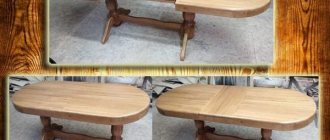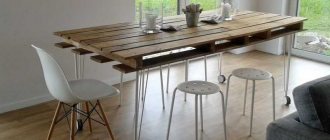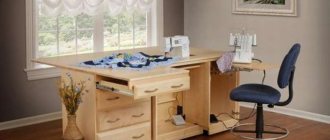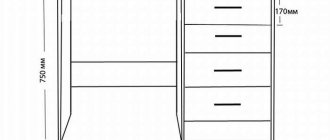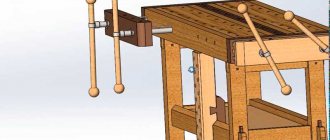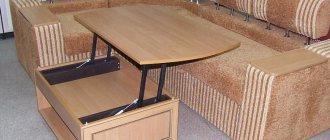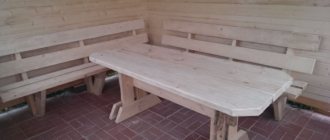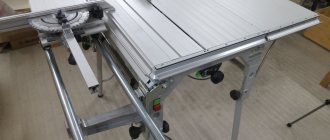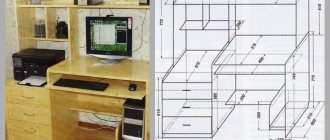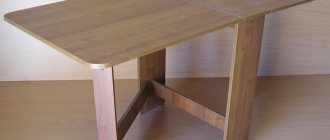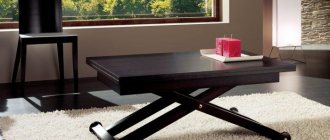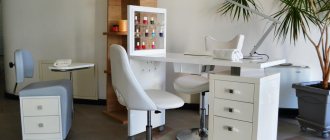Making an extendable table with your own hands is more difficult than a regular one, but sometimes it is necessary. Yes, for the average family a small table with up to four seats is usually enough, but the problem arises when guests arrive, who, of course, should be seated at the table. It is in such a situation that a sliding structure comes in handy.
A similar product can be purchased at any furniture store, but it is much more exciting to make a table with your own hands. Where to start, which table to choose for manufacturing, step-by-step instructions - you will find all this in our text today.
DIY extendable table
Required tools and materials
Most often, when assembling a kitchen table, furniture panels and chipboard (laminated chipboard) are used. The main advantage of the first option is ease of use. On sale there is a pine board that can be easily drilled and sanded. You don’t need a workshop to work with it – you can assemble the table right at home. Panel furniture also has disadvantages. It has to be sanded to a smooth surface and additionally treated with protective coatings - impregnation and varnish.
Particular attention should be paid to. The larger this parameter is, the stronger the furniture will be. A thin tabletop without additional reinforcement can bend under the weight of objects. For a table, it is not recommended to buy a furniture panel whose thickness is less than 3 cm.
Laminated chipboard is a more difficult material to work with: chips may form during cutting, and an edge will need to be glued to all open cuts. It is easier for novice craftsmen to buy a ready-made countertop made of laminated chipboard of the required size or order cutting and gluing of the edges when purchasing the material at a hardware store. Chipboard also has its advantages. These include a wide range of colors and a variety of textures.
To create a kitchen table you will need furniture fittings - fastenings and ready-made supports. Sometimes timber is additionally used. With its help, they prevent sagging of furniture made from panels. To do this, a rectangular frame is made from timber. This design is called the underframe. Its task is to distribute the stress that most affects the corners of the furniture. Then the tabletop is placed on the frame. The timber is also used as table legs.
Tools you may need are a drill, a screwdriver or a screwdriver. The legs are often attached to the top of the table using self-tapping screws. Sometimes metal corners are used as fastenings.
How to choose a suitable transforming table
Before you make a purchase, you should:
- Measure the dimensions of the room. It is worth paying attention to how much space the table will take up when folded and how harmoniously it will look in the interior. If you choose the right dimensions, the model will be used constantly in assembled form and conveniently unfolded on holidays when guests arrive. But it’s not worth overpaying for a huge countertop that won’t be used.
- Evaluate the functionality of the product. We need to consider whether the increased countertop area will be enough for visiting relatives and friends. You can see if there are any convenient additional features - drawers for storing cutlery, small shelves for napkins and small items.
- Check the quality of the materials and fittings from which the table is made. If the components are unreliable, the structure will quickly break down. Therefore, there is no need to chase cheapness and give money for short-lived products.
The more seriously you think about buying an extendable dining table, the longer it will last, will delight the owners and guests and will provide an opportunity to have a pleasant time at dinner parties and table conversations. Therefore, the UstanoviTV online store does everything so that the client can buy the best for his money. Experienced company managers talk in detail about the models, explain the advantages and disadvantages, and give advice on how best to fit into the interior. Cooperation with us will make your home cozy and comfortable!
Preparing for assembly
The instructions for assembling the kitchen table are simple. The first stage is preparatory. It starts with . First you need to decide how many people the table will be designed for. One seat is about 60 cm. Thus, the length of a table for 4 people will be about 1.2 m. The width depends on the area of the kitchen. For small rooms it can be 75-80 cm.
For professional assemblers, including tables, will depend on the type of structure. It’s easier and faster to work with ready-made furniture supports. In this case, all the work will consist of marking the fasteners and installation. It is best to use adjustable legs. Such supports can be adjusted to the desired height after leveling the tabletop. These legs are suitable for those who have uneven floors. Alternatively, you can make the table on two supports. They are sold in furniture stores.
Shape and dimensions
Kitchen tables can vary in size, as well as the shape of the table top and individual elements.
Oval or round
Dining tables for the kitchen area can be made with a round or oval tabletop. The oval table gives the kitchen a peculiar coziness and homely atmosphere.
Features of round and oval tables:
- round tables will not be appropriate in all kitchens. In small rooms they can take up too much space and block the passage. It is better to use an oval folding table;
- There are models that, when folded, have a round shape, and when unfolded, due to the additional tabletop, they take on an oval shape;
- folding options become a semicircle when folded.
Dimensions of oval, round structures:
- standard height size is 74-75 cm;
- the diameter of the folded tabletop is from 90 to 100 cm;
- when unfolded, the oval reaches a length of up to 130 cm.
Square or rectangular
Tables with rectangular and square shapes are in great demand because they fit into any design. However, they do not block the room.
A rectangular kitchen table is suitable for a small room; it will take up a small space, but will still serve its purpose. There are also products with rounded edges. They will be just a good option for apartments with small children.
Dimensions of square, rectangular tables:
- the height of the products is 75 cm;
- length is 80 cm and width is 70 cm;
- When unfolding the tabletop, its length increases by 30 cm.
Assembly steps
Let's look at how to assemble a kitchen table with chrome legs. This option is simple and can be applied to any countertop. First, let's put marks for the subsequent screwing of the legs. Let's lean the mount against the tabletop and mark the points for the screws with a pencil. After this you need to screw the mount. To do this you will need a screwdriver or screwdriver. Then you need to install the leg into the mounting location. It easily screws into a special hole in the center. Similar actions need to be done with the remaining supports.
A more difficult question is how to screw the legs to a wooden kitchen table. Such a design is much more difficult to assemble, since you need to think about the types of connections.
The classic one is strengthened with the help of a special base, which is a frame made of timber. The minimum height of each plank is 12 cm, and the thickness is 3 cm.
If the legs are made of timber, then their cross-section should not be less than 6x6 cm. Traditionally, the entire structure is assembled using a tongue-and-groove connection. Then a metal corner is used to fasten the slats and legs. After this, they move on to installing the countertop. It can be connected to the base using screws.
Product choice: square, oval or round sliding table for the kitchen
It is believed that a rectangular or square sliding table is the only correct solution for a small kitchen. However, if positioned correctly, an oval folding table for the kitchen is even better suited than a square one, because it does not have sharp corners that can hurt you, especially if you are talking about a small child. However, usually an extendable oval dining table for the kitchen is purchased when it is possible to install the table in the central part of the room.
The round design is the safest option for both small and large kitchens; it is easy to place correctly in the space. A round folding table in the kitchen can accommodate more people than a table of the same size but with right angles. The main disadvantage of such a product is the inability to move it close to the wall.
A rectangular extendable table can be placed either in the center of the room or near a wall
An extendable oval dining table for the kitchen combines the advantages of round and rectangular models: it folds out conveniently and can accommodate a large number of guests. Some designs can be moved almost close to the wall, so this form is considered universal and can be used in both large and small kitchens.
Helpful advice! If you install a folding table with photo printing on the tabletop in the kitchen, it will add unusualness and elegance to any interior style.
Classic rectangular and square products are convenient to place in any area of the kitchen. Such designs work well in corners, near windows or walls of a room. A rectangular sliding dining table with glass (or made of another material) is ideally located near the wall on ordinary days, and if you need to expand the circle of guests, it is simply moved to the center of the kitchen. Models of classic shape, depending on the size, are suitable for almost any kitchen. If there are small children in the house who could get hurt, you should choose tables with rounded edges.
A round or oval table will look great in the center of the room
Features of assembling a corner structure
A corner table is suitable for a small kitchen. This model saves space and looks quite unusual. To construct a corner table you will need a table top and 2 or 3 legs.
How to assemble a corner kitchen table (instructions and step-by-step guide):
- Mark the length and width of the future tabletop on the furniture board (both parameters are measured from the corner). Connect the two resulting points with a straight line or arc. The table cut can also be made curved.
- Cut out the resulting shape using a jigsaw. Sand all edges with sandpaper.
- Attach the leg to the tabletop and mark the attachment points.
- Screw the legs to the top of the table using self-tapping screws.
- If the corner table has only 2 legs, then for greater stability it can be additionally attached to the wall.
Another option to save space is to make one that will be a continuation of the corner kitchen. This design is multifunctional and easy to implement. The table can be used as an additional work surface or for eating at it.
The extendable table is convenient and compact. But not everyone has the opportunity to buy it, since the price of an extendable table is quite high. But all craftsmen who are ready to create household items with their own hands have the opportunity to make it themselves. Tabletops can be made with your own hands using glass or wood. Glass tables or those made from natural wood look very nice. But since natural materials are not cheap, it is better to entrust the cutting of the legs and tabletop to specialists so as not to spoil the wood. Very beautiful sliding tables - on one leg.
An extendable table is very convenient and compact; you can also make it yourself using a glass or wooden covering.
You can choose the design as you wish, for example, make the legs chiseled or curly. The sliding table will have the following dimensions (in millimeters):
- table height – 775;
- tabletop width - 885;
- tabletop length – 1245;
- insert – 375.
Making furniture yourself: advantages
Not every person can decide to independently manufacture various pieces of furniture, but such actions have several main advantages:
- Saving. This is a good opportunity to save your budget, because you don’t have to pay furniture makers for services.
- The most accurate measurements. You can not only pre-measure the place where the table will be installed, but also adjust some details while working.
- Creation of a unique design. Only on your own can you create an exclusive table that cannot be found on sale.
- Possibility to buy only good quality materials. Furniture shop craftsmen do not always act in good faith, and in order to earn more, they purchase low-quality materials and accessories. That is why it is recommended to do your own purchasing - you won’t fool yourself.
Making furniture with your own hands has a large number of obvious advantages.
Of course, in the absence of any skills in making furniture, making it yourself is a certain risk, because a beginner can simply ruin the materials due to inexperience. But, if you do everything slowly and thoughtfully, then even the first time you can get a very worthy result that you can be proud of.
Materials and tools that will be needed for modeling
In order to make such an extendable table, not many materials are required, so the piece of furniture will be inexpensive, but practical and beautiful. The most important thing is that all parts have the right size and are symmetrical. Materials you will need:
- wooden blocks (legs) – cross-section 85\85 mm, length 745 mm;
- frames connecting the legs (width - 105 mm, thickness 30 mm): 2 pcs. 925 mm long (+ 2 spikes - their length is 40-55 mm), 2 pieces 485 mm each (+ 2 spikes, 40-55 mm long);
- 2 wooden countertops of the same size – width 805 mm, length 625 mm;
- table top insert – width 375 mm;
- for the tabletop it is better to choose a carpentry panel (thickness 35-45 mm);
- sliding mechanism;
- wooden tenons for connecting frames (diameter 9-11 mm);
- a drill to create sockets into which the spikes will then be inserted;
- self-tapping screws for installing the sliding mechanism;
- glue for wooden surfaces (you can use PVA);
- machine for polishing wooden surfaces;
- sandpaper is loose;
- varnish for coating wooden surfaces;
- brush;
- ruler.
DIY sliding table - assembly
Once the parts are assembled, the modeling process can begin. First of all, it is necessary to mark the nests on wooden blanks for the legs. Frame spikes will later be inserted into these sockets to connect the legs. Holes must be made in accordance with the diameter of the tenon. It is better to “plant” the spikes with glue, in this case the structure will be much stronger.
First you need to assemble the underframe and only then begin assembling the main parts. A prerequisite is that the joining at the ends must be as accurate as possible. Place the spikes in the sockets and assemble the structure. It is not recommended to glue the parts right away; it is better to first assemble the entire table, see with your own eyes whether the dimensions and joints match, and only then glue the parts.
After all the steps described above, you need to start installing the insert. There may be some differences in the level of one or more parts, which can be easily eliminated with a grinding machine. The sliding table mechanism is mainly made of aluminum. Installation is carried out either using self-tapping screws or by gluing.
The next stage is the installation of the sliding mechanism. Attaching it is not difficult; just screw the guides to the long frames, and each of the sliders to its own part of the tabletop. It is better to mount the sliding mechanism by turning the table over onto the countertop. After installing the mechanism, be sure to check how the central insert will be installed.
Under the tabletop you need to install two slats the same length as the wooden central insert. This should be done for ease of use - when the insert board is not needed, it will be located under the tabletop and held in place by slats. After the assembly process, the finished product can be coated with stain.
A round table is considered real chic and luxury. Today they are the most expensive on the market, especially those made from natural wood. It is also possible to make a round-shaped extendable table with your own hands, the main thing is to have the desire.
Rounded countertops in the interior
It is known that any transformer can be with or without corners. All these varieties must meet the following parameters:
- An oval extendable table should not stand out from the background of the entire interior; it can be emphasized by chairs and a successful combination of materials. Filling with other smooth shapes will help create harmony.
- Oval tables should be positioned so that they can be approached from any side. This can only be achieved in spacious rooms. For a small kitchen it is difficult to achieve what you want.
- In accordance with the shape of the table, the dining area must have smooth lines. Oval tables take up a large area in the kitchen, and chairs used as space dividers hide the area, and this is not a suitable option for a small kitchen.
Oval tables are most often placed in the middle of the room, which is due to their size and spaciousness, because you need to sit at it from all sides. When choosing chairs for them, it is important to take into account the number of family members. Oval tables do not have corners, so they are safe and do not interfere with free movement around the kitchen, and they are inexpensive.
DIY round extendable table
In principle, the technique for assembling a round table is no different from the technique described above. The only thing is that the edges of the tabletop will have a rounded shape. To make it you will need:
- whatman;
- scissors;
- any glue for a wooden surface;
- timber for legs;
- a simple pencil;
- ruler;
- boards;
- plywood 8 mm;
- self-tapping screws;
- screwdriver;
- hacksaw.
Using a large compass, you need to cut out the shape of the future tabletop from whatman paper. Only then cut it out of wood. What kind of tabletop it will be - glass or wood - depends on the desire of the owner of the future sliding table.
Glass and wooden sliding tables look much more beautiful if they have one curly leg.
Rules for choosing material, color, shape
Folding kitchen tables usually consist of several types of materials. For example, the legs and straps may be wooden; table top, folding floors or inset board - made of veneered chipboard; but the fasteners, as a rule, are steel. Most often, wood, glass, laminated fiberboard/chipboard/MDF, plywood and even plastic or aluminum are used to make folding and sliding tables.
- The most reliable legs, supports and straps are made of wood, but they will be relatively heavy and expensive;
- A tabletop made of tempered glass is not afraid of scratches, it is quite durable and looks beautiful, but caring for it will not be the easiest, in addition, it is cold and “ringing”;
- The solid wood tabletop is beautiful, reliable, can be restored, warm and pleasant to the touch. But it makes the structure heavier and costs more;
- Veneered chipboard, MDF or fiberboard - does not differ in appearance from wood, weighs lighter, costs less, so this material is optimal for a tabletop;
- Laminated chipboard or MDF is light in weight, easy to clean and the most affordable material, but loses in durability and appearance;
- When choosing a folding table, keep in mind that the base, supports, legs, frames and other parts of the structure are more reliable from solid wood or metal.
The shape of the table top for folding and sliding models can be any, most often it is:
- Square ones – they take up space rationally and are quite roomy at the same time, so such models are recommended for small kitchens. As a rule, square tables become rectangular when folded out;
- Round - require more usable space, so are less suitable for a small kitchen. But it is round tables that are best able to make a space cozy. When folded, round tables become oval due to the additional inset board;
- Oval ones take up space more efficiently and are more spacious than round models. At the same time, they are also beautiful and traditional;
Oval book tables, assembled halfway, become semi-oval and in this form are ideally suited for a small kitchen.
- Rectangular ones are the most common models due to their spaciousness and convenience. Suitable for both large and small kitchens and can be folded out like a book or extended to double in size.
After the material and shape are chosen, it remains to decide on the color. In a small kitchen, it is very important that the visually folding table does not clutter up the space. Therefore, dark colors are inappropriate. It is better to choose light shades, but, of course, taking into account the color of other kitchen furniture. Read more about color combinations in this material: color in the kitchen interior: bright ideas and traditional combinations. The photo below shows an Ikea folding table, model Ingatorp.
What you need to know about assembling an extendable table with your own hands
All about the countertop
First of all, you need to decide what material and what shape the table will be made of. Pine or chipboard are perfect. Naturally, pine boards are preferable, since they are much stronger; in addition, pine boards are environmentally friendly. The boards are cut and processed according to the size of the future tabletop. If the table is still made of chipboard, the sheets need to be cut into 3 parts, 2 of which will be the same size, and the 3rd part will serve as an insert in the center of the table top. Before assembling this piece of furniture, it is better to draw a drawing or use ready-made drawings. In order for it to be strong and last a long time, it is necessary to maintain accuracy in calculations. Only in this case it will not “float” and will be durable.
The legs are mainly made from bars, which can be purchased in the store. The color scheme of the tabletop and legs should either be the same or differ in color by 1-2 tones. Moreover, the tabletop should be darker. A prerequisite for the manufacture of a sliding door is the proportionality of the dimensions of the tabletop and legs. Legs that are too thin will not be able to support a large tabletop. The length of the legs should correspond to the overall look - a small coffee table will not look good with long legs. But if the idea is an unusual sliding table, then special attention is paid to marking the center of the bar. The legs can be made curly. It is also possible to make a curly leg yourself. To do this, just learn the technique of cutting shapes from wood.
Tsarga are strips that connect two parts at the ends. To mark the drawer, you need to place the tabletop on a comfortable surface “face down”, but before doing this it is better to lay a soft cloth so as not to damage the surface. It is better to make each of the drawer blanks a little larger than the intended size. Excesses can always be removed, but shortcomings in length cannot. The drawer is processed using a lathe and a milling machine.
All about assembly
The most important stage is assembly. Particular attention should be paid to the connection of the side frames with the leg or legs. To do this, each tenon must correspond to a pre-prepared groove. Don't forget about the grooves - they provide a strong connection. When using glue for structural strength, after drying, all excess glue must be removed with sandpaper. In any job, inconsistencies can arise, such as tabletop edges that don't match. This can be easily fixed with a sander. Then clean with sandpaper and coat the surface with varnish.
Transformable table with collet
The drawer is a connecting part that is located between the supports and the table top. It is installed around the entire perimeter and ensures the stability of the structure. Modern production technologies and high-quality fittings make it possible to make a dining table that will last a long time even with frequent unfolding.
Furniture with a durable drawer can withstand heavy loads both when assembled and disassembled. If metal fittings are also used, the product can be used for several decades. This table looks solid and massive, which allows it to fit harmoniously into a classic interior. But for some design ideas, the excessive heaviness of the model will be undesirable. When choosing a table, you should pay special attention to the convenience of the drawer. If it is poorly designed, it will be awkward for diners to cross their legs.
There are several types of sliding table tops. Depending on them, the products will differ in ease of unfolding, additional surface area, and appearance.
Custom center insert
This is a reliable, durable design. When folded, the furniture has a joining seam in the middle of the tabletop, and when unfolded, there are two of them. If you don’t look closely at such little things, then the table will have no visual flaws.
The principle of the sliding mechanism is quite simple. The insert is located in a loose state under the tabletop, in the center. When the table needs to be unfolded, the sides of the surface are moved apart, and the central part is removed and placed in special grooves. Then the sidewalls move and fix the insert. The countertop area of such models usually increases by a third or half of its size.
Such tables, made many years ago, still serve their owners, as they are quite difficult to break. But during operation, they develop defects - the side parts moving along the wooden grooves can become wedged or skewed. Therefore, in modern products with a central insert, metal guides are installed. This not only solves problems with jamming of the sides, but also ensures ease of movement when unfolding and folding the product.
Center insert with rotating mechanism
In such a table, the central insert is divided into two parts that can be rotated. When the product is assembled, it looks the same as with a regular insert. When the model unfolds, there are more docking points. The sliding mechanism is similar to that described above. The side parts of the tabletop are moved to the sides, then the rotating parts are removed, unfolded, and placed in the right places. The sides move, and the surface area becomes larger by 30–40%.
The advantage of this rotary mechanism compared to the previous model is the high speed of table disassembly. Modern fittings and manufacturing technologies allow owners to easily lay out the table, spending very little time on it - no more than one minute.
Double table top
The peculiarity of this product is the simplicity of the mechanical components. When folded, the tabletop looks somewhat bulky, since its thickness is doubled. To unfold it, just lift the top and simply pull the second layer of the surface to the side. The central part of the tabletop will fit into the available space and will be ready for use. The surface area of such a table is exactly doubled.
The disadvantages of this design include low strength. The table should not be subjected to heavy loads, as it may not withstand it and break. Perhaps that is why this option is not common.
Sliding model with moving supports
For such a table, the principle of increasing the area of the tabletop is fundamentally different. If for the listed options only the tabletop moved, now the legs of the product will also move. To unfold, you need to grab the drawer from below and push it apart. The additional part at the table top can either rotate or move apart. The area of the model increases from 30 to 50%. The product extends easily and is characterized by stability. But to make it look aesthetically pleasing when unfolded, it is better to decorate the work surface with a tablecloth.
Folding model with moving supports
This table also has supports that move. When folded, the product looks the same as the model with a double tabletop. To unfold, the drawer also needs to be moved apart. Having completely moved the supports, you need to open the tabletop according to the “book” principle and place it in the center. This is much more convenient to do if the structure has a mechanical lifting device. The advantage of such a table is a significant increase in area (twice), and the disadvantage is low strength. Under no circumstances should the product be overloaded when unfolded.
Advantages of sliding tables
The main and obvious advantage of a do-it-yourself sliding table is its versatility. A special mechanism helps turn a small compact table into a large dining table. That is why it is convenient for small apartment rooms. It does not take up much space, but allows you to seat about 9-10 people.
Due to the fact that there is a huge amount of material on the commercial market for creating an extendable table at home, it can be made not only multifunctional and comfortable, but also beautiful and stylish.
Tables that extend can be classified as follows:
Transformers.
Sliding tables received this name due to their unique ability to transform. A seemingly small table can turn into a quite spacious dining table. Transformer tables are round or oval in shape. The main distinguishing feature of these tables is the increase not only in their size, but also in height. You can make such a table with your own hands. To do this, it is enough to have a drawing. In addition, transformers have recently become particularly popular not only because of their convenience, but also because of their design excellence. Basically, transforming tables are made of wood or glass. Mirrored ones look very beautiful and can save a lot of space in an apartment or house.
Standard sliding tables.
These types of tables are no less popular. They are made of natural wood, fiberboard or chipboard. The advantage is their compactness. Besides everything, making an extendable table with your own hands is not difficult. It is enough to follow the instructions for their construction.
Any extendable table means comfort and versatility. All of them are practical and economical. You can make a table not only for eating, but also for drawing and games. A DIY extendable table is a wonderful way to make a child’s room comfortable and stylish. In addition to all the advantages, transporting sliding tables is much easier than regular ones.
A DIY extendable table for a children's room is an ideal solution, especially if there are several children in the family. In addition, it can be combined with a bed. Well, the most important positive side of a do-it-yourself sliding table is its economical cost.
A folding table is an excellent solution for a large family or friendly company.
When folded, it takes up minimal space, and if necessary, the tabletop area is significantly increased due to additional inserts.
This design is suitable for use during the holidays to seat all guests.
You can buy a folding table in a store or make it yourself.
Which countertop shape should you choose?
It is important at the stage of designing the table to decide on the shape of the tabletop that will suit the specific type of room. We will take a closer look at the most common options.
Table 2. Shapes of table tops for an extendable table.
| Shape, illustration | Description |
Square | When assembled, such products can be miniature or large - this will depend on the size of the kitchen and dining room. The extendable table can accommodate 6 to 8 people. The only downside is that due to the presence of all four legs at the end, only one person can be seated, and this is not always convenient. |
Rectangular | A table of this type can be installed in both small and large rooms; it can accommodate up to 12 people. This type of countertop should be chosen by large families or those owners who often invite a large group to visit. |
Round | This is a rather unusual shape for an extendable table. This design is also suitable for rooms of various sizes - due to the lack of corners, the table will not take up too much free space, and thanks to this feature it can be moved around the room if necessary. In addition, such a model is ideal for an apartment where small children live, because the risk of injury by hitting a sharp corner is minimized. When assembled, the diameter of such a tabletop is about 90-110 centimeters. When unfolded, the structure becomes oval. |
Octagonal | This is an unusual version of an extendable table top. It is more difficult to make such a design, so it is better for novice craftsmen not to choose it. However, the finished table will be very functional. When assembled, it can accommodate six to eight people; when disassembled, it can accommodate twice as many. This is an excellent option for a large family, in which it is customary to have breakfast at different times, and have dinner all together, at a large table. |
Video – Custom extendable table
Folding table options
Folding tables can be made in various variations and sizes:
both small or and
large -
or
Folding tables also differ in design complexity -
from very simple ones like a folding one to those equipped
with a special
mechanism
Materials
A variety of materials are also used to make tables.
Tabletops are made of glass,
plastic, chipboard, MDF,
wood.
Indispensable for some
metal
folding
legs
are very practical and reliable (you can make them with your own hands from
chrome-plated
pipe).
How to make a table from a metal profile with your own hands:
The purpose of folding tables can be very different. Here are just a few examples:
Folding table for trade
Folding massage
table
General recommendations for choosing folding dining tables
Choosing a folding table is a responsible undertaking. Various factors must be taken into account simultaneously.
- Room area.
- Place of permanent location, and also imagine how the picture will change after the transformation of the product.
- Minimum and maximum number of seats.
- Execution material.
- Reliability of fittings.
- Harmonious combination with other interior items in color and style.
- Decorative design.
A folding dining table is a functional piece of furniture that will help you use kitchen space rationally and economically. It must simultaneously combine beauty and comfort, so that family lunches and dinners evoke only positive emotions.
Folding-extendable dining table
Even a novice home craftsman can make such a table. Despite the lightweight design, it turns out to be very strong.
When assembled, the tabletop width is 700 mm, length is 1200 mm. Its area increases due to an additional central insert. The total length of the table when extended is 1670 mm.
This table can easily accommodate eight adults: one at each end and three on both long sides.
Materials and tools
In order to make a folding table with your own hands, we will need the following materials:
- laminated chipboard 25 mm thick;
- PVC edge with hot melt adhesive applied to it (thickness no more than 2 mm);
- aluminum corner 50 x 50 mm (500 mm) – 4 pcs.;
- telescopic guides (500 mm) – 2 pcs.;
- thick metal leg (710 mm) – 4 pcs.;
- furniture lock – 6 pcs.;
- M4 screw 10 mm;
- self-tapping screws 20 x 4 mm and 16 x 3 mm;
- household gloves.
Tools required for work:
- tape measure, pencil, long ruler, marker;
- clamps (for cutting laminated chipboard sheets);
- building level;
- milling cutter;
- construction hair dryer (heat gun);
- screwdriver;
- drill and drill bit with a diameter of 4.2 mm;
- a circular saw.
- a jigsaw and a fine-tooth file (so as not to chip the laminated edge of the chipboard)
Drawing and cutting of material
Before you start work, you need to decide on the dimensions of the future product and make a drawing of the folding table. In our example, the dimensions of the sliding tabletop when folded (left) and with an insert (right) are as follows:
Stages of work
Step 1.
To begin, we mark and cut out three parts from the laminated chipboard that will serve as a tabletop: two identical parts
700 x 600 mm
and one for insertion -
700 x 470 mm.
In order to
make cuts on chipboard
without chipping jigsaw will do.
Important:
if the part is subsequently processed with a milling cutter, it is worth adding a couple of millimeters to each side.
Then the chipboard sheet is attached to any flat surface with clamps.
We set the edge of the cut using a level and move the jigsaw calmly and carefully. Step 2.
Processing the edges of parts
with a router
gives a perfectly even cut.
The router should also be driven slowly
and carefully, working through each section of the cut.
Step 3.
The ends of the parts are covered
with PVC
edges To do this, we fix the part with a clamp vertically on a stool or table. We cut off the required piece of edge and apply it to the cut, heating it
with a hair dryer.
We carry out all work wearing household gloves.
After the glue has completely dried, you can
continue
.
Step 4.
For safety, you can file off
the sharp
corners on all aluminum corners and
round
them off.
Step 5.
Now we take two corners and
a guide.
On the outside of one corner, mark 25 mm from the rounded edges and draw a line that will divide the side of the corner
in half.
We perform the same procedure with
each
of the remaining corners.
Step 6.
We attach the parts of the guides to the corners and
mark
the holes for the bolts.
We tap them a little with a nail (so that the drill does not jump off) and drill.
We fasten them with bolts.
Step 7
We got two designs from the corners.
We place them on a flat
surface in this way: corners with
thin
guides (movable) on
the inside,
corners with thick guides (fixed)
on the outside.
We drill four holes in the fixed corners and four in the moving ones.
Note:
all holes in movable guides are made from the outside, in fixed ones - from the inside (that is, the holes should be on opposite sides of the product).
Step 8.
Place two identical laminated chipboard pieces on a flat surface and turn them
face
down.
We place both telescopes
(moving side inward and fixed side outward) at a distance of
8 cm
from each edge.
The middle of the telescope should coincide
with the joint of the parts.
Step 9
We screw
the movable side screws (20 x 4 mm) to the right side of the tabletop, and
the fixed side
to the left.
Step 10
a lock
to each side of the table using 16 x 3 mm self-tapping screws.
Step 11
Open the locks and
move
the tabletop apart.
Between them we insert the middle
piece face down.
Push the tabletop
to create a flat surface.
Not everyone is lucky enough to have a large kitchen, but in small ones every square centimeter counts. That’s why our compatriots loved folding tables so much. The article discusses some wooden structures, accompanied by drawings, calculations of materials and recommendations for assembly.
You can make a folding table with your own hands; for this you need to arm yourself with ready-made drawings or develop your own, and also stock up on tools and materials. The table can have a different shape and area, but in order for it to occupy a small area, you need to make it in the form of a transformer.
Types of folding table designs
Folding tables come in the following types of designs:
- Stationary, where the tabletop is transformed. They can be folding, when the tabletop is folded out like a book, sliding like a slider, or when parts of the tabletop are moved apart from the center, and another additional element is placed in the center.
There are also models with additional “wings”. Outwardly they resemble a standard kitchen table, but with simple manipulations they increase the usable area by up to 40%.
- Portable bistro-style folding tables are suitable for very small kitchens - they are easy to assemble and unfold. The photo below shows the Russian-made Madrid model.
- Collapsible. They are disassembled into individual elements and stored until needed. No special tools are required for assembly. Such models are often equipped with a transformation system and can be adjusted in height.
- Built into furniture. They are a mobile part of the kitchen unit, which can be removed at any time. As a rule, it matches the height of the kitchen set.
- Folding. They are mounted on the wall, and if necessary, the tabletop can be folded back and fixed with a leg. When assembled they are a narrow shelf, and when disassembled they can accommodate from 1 to 8 people, depending on the area of the tabletop.
Hanging table
Such a table practically does not take up space in the kitchen until it is needed, it is easy to unfold and assemble, and making such a design is quite simple. The table is a load-bearing part, fixed to the wall, and can be tilted when necessary. Moreover, chains, mechanical or folding brackets - wooden or metal scarves and frames, as well as one or two legs folding under the base can serve as limiters and supports.
Hanging table options
The drawings below will give manufacturing tips.
Hanging table with support - telescopic bracket. 1. Table top. 2. Furniture hinges. 3. Telescopic supports
Table drawing: support - folding frame made of bars
In addition, watch a video about the process of making a table with folding supports and hanging on a tiled wall.
Stages of manufacturing an original hanging table
Now let’s make a combined buffet table for the kitchen.
- Let's prepare boards (slabs) with the dimensions indicated in the drawing. To do this, we apply markings, carefully cut out, and then sand each surface with sandpaper or a sanding machine.
- Using screws, we assemble the frame, checking with a square and a level the accuracy of the elements being set. We attach the side of the top shelf with wood glue. The middle shelf can be secured with self-tapping screws through the vertical walls or with shelf holders - furniture corners (corner tie).
- We fasten a piano (continuous) hinge or several individual hinges in a row to the bottom of the frame with screws. We attach the second part of the hinges to the inside of the tabletop. If the canvas is not strong enough, you can add two or three stiffening ribs on the outside.
- We screw the hinges onto the side surfaces of the frame and into the corners of the tabletop from the inside. We secure the chains by adjusting them in length until the tabletop is completely horizontal when open. Close the countertop door, mark the places for hooks and loops on the end surfaces of the buffet and table on both sides, and screw in the fittings. Now the tabletop is fixed in a vertical (folded) position.
- We attach hinges on the back of the frame for hanging on the wall. If desired, the sideboard can be sewn up at the back with plywood or the structure can be left open.
- We paint the surface with a bright, glossy varnish. The buffet table is ready!
How do extendable tables work?
This kitchen table is a mechanism that can be transformed in one or two movements. The design is equipped with a reliable frame that can withstand multiple manipulations with its unfolding. It’s good if metal or wood is involved in the production of such a device. Plastic has a more fragile base, which quickly wears off and the product fails.
An extendable kitchen table must have strong supports that can withstand significant loads. Metal copes best with such functions: it is more reliable and durable.
The high cost of the product is mainly due to the fact that it is impossible to make the design yourself. However, this fact does not stop people from making another purchase.
Folding kitchen table with cabinet
Let's consider two designs of a folding table with a cabinet. The first one in the kitchen takes up more space, but has a drawer and shelves in the cabinet, which are useful for storing small items. The second one is on wheels, narrow, and can be built into a line of kitchen furniture.
Stationary folding table with cabinet shelves
Let's try to make a cabinet table, as in the photo below.
To make a table, we will need a jigsaw, a screwdriver, and for the grooves for the hinges, a router or a bit attachment for a screwdriver or drill.
- Preparation of elements. Study the drawings and prepare elements with the dimensions and materials given in the table.
Table 1. Calculation of materials
| Drawing position | Detail | Quantity, pcs. | Size, mm | Material |
| 1 | Folding tabletop panel | 1 | 600x600 | plywood 25 mm |
| 2 | Fixed tabletop panel | 1 | 600x475 | plywood 25 mm |
| 3 | The wide part of the guides for the retractable leg on the folding part | 2 | 530x30 | plywood 18 mm |
| 4 | Wide part of the guides for the retractable leg on the stationary part | 2 | 120x30 | plywood 18 mm |
| 5 | Upper leg movement limiter | 1 | 122x30 | plywood 18 mm |
| 6 | The narrow part of the guides for the retractable leg on the folding part | 2 | 530x20 | plywood 18 mm |
| 7 | Narrow part of the guides for the retractable leg on the stationary part | 2 | 120x20 | plywood 18 mm |
| 8 | Lower leg movement limiter | 1 | 122*20 | plywood 18 mm |
| 9 | Side walls of the cabinet | 2 | 720x520 | MDF board 19mm |
| 10 | Horizontal elements of the cabinet | 3 | 520x312 | MDF board 19 mm |
| 11 | Vertical partition between shelves | 1 | 418x312 | MDF board 19 mm |
| 12 | Wall - drawer movement limiter | 1 | 312x184 | MDF board 19 mm |
| 13 | Shelf | 1 | 310x250 | MDF board 19 mm |
| 14 | Door | 1 | 447x346 | MDF board 19 mm |
| 15 | Shelf | 1 | 310x250 | MDF board 19 mm |
| 16 | Decorative drawer front | 1 | 346x209 | MDF board 19 mm |
| 17 | Drawer front | 1 | 310x150 | MDF board 19 mm |
| 18 | Side walls of the box | 2 | 341x150 | MDF board 19 mm |
| 19 | Rear wall of the drawer | 1 | 272x120 | MDF board 19 mm |
| 20 | Bottom | 1 | 341x272 | MDF board 19 mm |
| Strips covering the bottom of the cabinet from the end | 2 | 300x20 | plywood δ5 mm | |
| Retractable leg | 1 | h 702mm, Ø: 55 mm top, 30 mm bottom | wood | |
| The head of the leg moving along the assembled guides | 1 | 80x80 | plywood δ18 mm | |
| Fittings and purchased items | ||||
| Door and drawer handles | 2 | |||
| Drawer guides | 2 | |||
| Furniture hinges for tilting the tabletop | 2 | |||
| Cabinet door hinges | 2 | |||
| Furniture edge for open ends of slabs | 6-8 m | |||
- On details pos. 1, draw an arc that will be the rounded edge of the folding part of the tabletop, using a homemade compass: a nail, thread and a pencil. Place the nail exactly along the axis of the workpiece. Cut out the arc with a jigsaw.
- On a flat surface, place the two pieces of tabletop side by side, flat sides facing each other. Use a router or a crown to drill slots to fit the size of the hidden butterfly hinges. Secure the hinges with self-tapping screws. Before you start drilling, attach the hinges to the workpieces and mark with a pencil.
- On the reverse side of the tabletop from parts pos. 3-8, form and fix guides with a stop using self-tapping screws - a channel for the movement of the leg. Pos details Cut 5 and 8 at 45°. Please note that the ends of the upper planks (items 3 and 4), directed towards the junction of the tabletops, are sawn at 45°, otherwise they will prevent them from folding. Attach a head to the retractable leg—a square of plywood that will move along the guides. Insert the stem head into the canal and check its progress. If something gets in the way, you need to sand it down. Paint or varnish the tabletop.
- All details of the cabinet pos. Cut 9-20 with a jigsaw, router, or manually smooth the edges. On the end surfaces that will be visible, use an iron to secure the furniture edge. Stepping back about 100 mm from the edge and marking the door and side wall of the cabinet, drill holes for the hinges. Attach the handle to the door.
- Paint the details of the cabinet. Using a square and a level, assemble the cabinet according to the drawings, starting with the lower parts. To fasten the elements, use wooden rods, self-tapping screws and wood glue. Attach guides where the drawer moves.
- Make a drawer, controlling the right angles and diagonal. Attach guides to the side walls. Fix the front panel and handle.
- Install the countertop. To do this, secure the stationary part to the cabinet using wood glue, and then secure it on the inside with self-tapping screws. Insert the box.
The table is ready!
Narrow table-book on wheels
Now we’ll make another table that can fold compactly and open one or two folding tabletops. For ease of movement, the design is complemented by wheels.
All components and parts are made of chipboard, the edges are finished with furniture edges. The table can be painted, laminated with film or varnished. The consumption and dimensions of the parts are given in Table 2.
table 2
- Let's make a base frame according to the given diagram. To do this, we use wooden rods, screws and glue. U-shaped wheels are attached with self-tapping screws.
- Now you need to assemble two supports for the tabletops, which, when closed, are retracted under the base.
- We attach the supports to the base using piano hinges. If desired, you can mount them on one or two racks. We control the assembly with a level, and upon completion we check how the parts move relative to each other.
- We attach the tabletops to the base using piano hinges. If you are worried that the leg will “move away,” attach a corner to stop the movement on the inside of the tabletops.
- If you want the wheels not to be visible when folded (when stored in a niche of kitchen furniture), add a plinth to the base by cutting a groove for it in the stiffening rib.
Finally, watch a video on how to make an extendable table for your kitchen yourself.
The average family usually consists of 3-4 people, so a small dining table fully meets the needs of each family member. What to do if guests are going to come to you? The answer is obvious: use a table that can be extended if necessary. You can not only buy such a product at a furniture store, but also make it yourself.
In this article we will tell you how to make an extendable table with your own hands. You, in turn, will be able to make sure that the manufacturing process is completely simple.
Types of kitchen folding table
In almost every apartment, the kitchen space has very small dimensions, so it is worth choosing the appropriate furniture for it. Before buying a dining table, it is worth finding out for what purposes it will be used - just for breakfasts, lunches, dinners with the family, or whether it will host guest meetings, festive lunches, dinners with luxurious feasts. All these little things must be taken into account so that there are no additional inconveniences later.
Stationary
Stationary tables are one of the types of furniture that will be a good option for a small kitchen. These models are ordinary small products with a tabletop of different shapes. They can be round, square, rectangular, oval.
Features of the sliding design:
- The design is compact in size. When assembled, it takes up little space;
- Usually there is a niche under the tabletop in which an additional tabletop is stored;
- To disassemble the product, simply move the tabletop apart. It should be pulled from both sides by the edges;
- a space will be created in the center into which an additional part will need to be inserted. It is usually inserted into special grooves;
- it turns out to be a large table that increases by 30-40 percent.
Portable
Portable products are very convenient models for small kitchens. They have another important quality - light weight and compact size.
When assembled, this furniture can be easily moved to another room or taken with you to nature, on a picnic.
Types of portable tables:
- classic portable table - this option has a simple mechanism. Transformer tables fold like butterfly wings, both halves simply fold and fall down. The result is a kind of folded structure that can be easily carried or loaded into a car;
- table suitcase - this option is very original; when assembled it is still small. In appearance it looks like a compact suitcase with a handle;
- table book - the design of this product is somewhat similar to the classic versions. When assembled, it looks like a flat book. Compact dimensions allow this product to be carried or transported outdoors.
Suitcase table
Desk book
Collapsible
Collapsible tables do not fold out, but are completely disassembled into individual components. These options will be appropriate for rooms where there is very little space, so little that there is not even room to place a table.
The main qualities of these products:
- simple design that can be easily assembled using available tools;
- all structural parts of this type are fastened using special fasteners;
- Usually on the back side of the tabletop there are grooves into which the legs are inserted;
- all legs are screwed with ordinary bolts and nuts;
- Additionally, some models may have height adjustment of the product.
Built-in
Built-in tables are transformers for the kitchen, which have not just tables, but a whole set with various cabinets, drawers, and bedside tables.
Features of built-in structures are as follows:
- tables of this type usually come with a kitchen set; they simply pull out when necessary, install them on a support, and then slide them back in again;
- There are models whose work is based on the book principle. If necessary, the tabletop folds back like a book to the main wall of the cabinet;
- built-in kitchen products consist of a small block to which a countertop is attached, as well as a special support for the table;
- These models, when folded, form a small tabletop, which can accommodate a family of 3-4 people. These models are not intended for holidays; it will simply be impossible to place a large amount of dishes on them.
Folding
Folding products will also be a good option for a small kitchen. When assembled, they occupy a small space, yet fully perform all their functions.
Characteristics of folding tables:
- the design of folding products is similar to sliding products, only folding models have a book-folding method;
- Usually, when assembled, one part of the tabletop is used, the other part is lowered down. If it is necessary to increase the size of the table, the second part is raised and attached using a special mechanism;
- Additionally, these models can be equipped with bedside tables in which you can put away dishes, kitchen utensils, and food. This option will be appropriate for very small kitchens, in which every centimeter is worth its weight in gold.
Equipment, materials and tools
Before you start making an extendable wooden table with your own hands, you need to prepare the following items:
- Laminated chipboard or wood panel for the tabletop;
- tabletop insert;
- chisel;
- screwdriver;
- roulette;
- sliding mechanism;
- drill;
- self-tapping screws for installing the sliding mechanism;
- hacksaw;
- screwdriver;
- Bulgarian;
- frames connecting the legs;
- ruler;
- wooden blocks for making legs;
- calipers;
- sander;
- wooden tenons for connecting frames;
- plane;
- construction knife or scissors;
- hammer;
- paint brush;
- loose sandpaper;
- file;
- jigsaw;
- varnish for wooden surfaces;
- PVA glue or any wood glue.
Step-by-step manufacturing of an extendable table
Before you begin assembly, you need to know the basics of design, that is, the requirements that apply to sliding tables of any type.
First, the table legs must be strong and durable enough. Their attachment to other elements should be as reliable as possible. Secondly, the tabletop itself must also be durable and strong.
The entire table must withstand heavy loads and be stable. Its surface should be practical and easy to use.
Is it possible to make an extendable table yourself?
Extendable tables can be made without the help of specialists. Their design is simple: four legs and six sides are needed to assemble a complete structure. Plywood is useful for making a drawer to which the legs are attached; the remaining parts are fixed with horizontal strips. All table elements must be the same color.
It is better to order sawing of parts from professionals: at home it is unlikely that it will be possible to achieve an even cut and dimensional accuracy.
The legs and plywood are sanded, varnished and the procedure is repeated.
Extendable tables will make the environment cozy, spacious and functional. They will bring aesthetics to the room and save valuable centimeters of space.
Preparing the main elements
The main elements are the tabletop and legs. The good thing about wooden dining table components is that they are environmentally friendly, reliable, durable and practical. Nevertheless, this material is most often used.
The tabletop can be made of either natural wood (oak, pine, walnut) or laminated chipboard (laminated chipboard).
You can make table legs yourself or purchase ready-made ones. Finished legs are round, square or carved. In addition, metal versions of this part are also available for sale.
Round dining table
It is easiest to use wooden panels for the base of such a table. 7-10 centimeter strips are used as cross-shaped supports. Sequence of stages for assembling the structure:
- Combine the blanks for the tabletop with each other.
- Determine the center, draw a circle of the desired size and cut out two semicircles.
- Process the edges with a milling machine.
- Cut the legs for the table, first rounding them at one edge.
- Drill through each leg in the middle.
- Fasten them in pairs with bolts.
- Connect pairs of racks with wooden round timbers.
- At the bottom of the legs, install a wooden strip that holds the legs of the chair together.
- Install 2 halves of the tabletop onto the finished structure and secure them.
Assembling the table from prepared parts
The first stage is cutting and cutting out 2 pieces of the tabletop. If necessary, finish the ends and cover the surface. At the inner end of each part, 2 holes (8-10 mm in diameter) are drilled for the dowels of the removable elements.
Then a U-shaped box is made from the sidewalls, the corners of which are fastened from the inside with an aluminum corner. So that the box can move above the base, the reverse parts of the guides are fixed to the inside of the side parts of the body.
A tabletop is installed on top of the box. These elements are fastened together using aluminum corners.
Now you can proceed to installing the insert. The sliding mechanism, which is most often made of aluminum, is best secured with self-tapping screws, for convenience, turning the table over and placing it on the tabletop. The guides of this device are screwed to long frames, and the sliders are screwed to one of the 2 parts of the tabletop.
To remove the insert when not needed, 2 slats are attached under the tabletop, which will hold the insert, hiding it inside the table structure.
The design of the sliding table can be changed if instead of 4 supports you use 2 wide ones or even leave one massive leg with a cross or platform. Also, these elements can have different shapes, for example, they can be made from figured or chiseled ones.
Features, advantages and disadvantages of folding tables
Each model has features that are recommended to be taken into account when choosing . These are the shape, the folding mechanism, and ease of use.
Types of kitchen folding tables according to folding method
A book table is suitable for a small kitchen . This simple and versatile option will fit into any interior. When folded, it takes up little space; its base consists of a cabinet with drawers in which it is convenient to store small kitchen utensils. The book mechanism unfolds easily.
If the table is often deployed, pay attention to the quality of the design: the mechanism must be durable so as not to break over time. Among the disadvantages, the heavy weight is noted - assistance is required to move the table from room to room.
For kitchens of any size choose a butterfly table . This is a design with shelves located on the sides. There are two tabletops located opposite each other. The butterfly mechanism is durable and difficult to break. Thanks to the shelves, the furniture looks original and light; it is decorated with decorative elements - flowers, souvenirs and candles.
Another option is a transforming table . It increases its area due to the retractable middle. These models have wheels, making them easy to move around the apartment. Transformers are equipped with wear-resistant mechanisms; they are used on holidays or every day. These options are suitable for any kitchen, affordable and easy to use.
Ergonomics and convenience
The folding mechanism is convenient not only when receiving guests . Housewives also use it when preparing dishes. For example, during the winter harvesting season, when a lot of space is required for jars and vegetables. It is convenient to use folding furniture while working - place your laptop and documents on the tabletop.
Such furniture is purchased for dormitories, dachas and country houses. The purchase helps save money, avoid cluttering the room and properly organize the kitchen space.
Square, rectangular or oval
Oval options look elegant and are suitable for arranging spacious rooms . Due to the lack of corners, such tables are purchased by families with small children - they are less dangerous. The oval looks harmonious in both square and rectangular rooms and fits into any interior.
It is recommended to purchase a table with a width of 109 cm and a length of 200 cm - when disassembled, up to 10 people can fit behind it. The oval table is a comfortable place to talk or receive guests—everyone is in full view of each other.
A square table is a suitable choice for a small kitchen . Place it in a corner or against a wall. Square furniture looks powerful and expensive. The recommended length of one side is 1.1 m. The disassembled table can accommodate up to eight people.
The rectangular design is suitable for a spacious rectangular kitchen . When assembled, the table stands against the wall or in a corner; when disassembled, it is taken to the center of the room. Dimensions for a company of seven people: width 1 m and depth 1.6 m.
Interesting things on the site:
Choosing a kitchen corner for the kitchen with a table and chairs
Modern oval tables for the kitchen
White kitchen tables: dining, glossy and sliding
